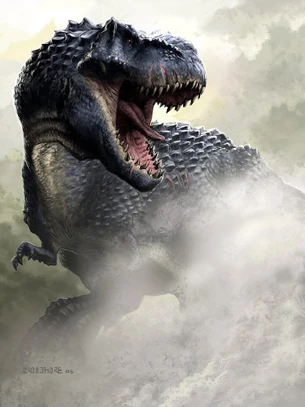
The V. Rex, Vastatosaurus rex, is a large, unique tyrannosaurine tyrannosaurid from Skull Island, descended from Tyrannosaurus. It measures 40-50 feet long.
The biggest terrestrial predator on Skull Island is the V. rex. Like their prehistoric fellow tyrannosaurs, Skull Island V. rexes have little competition for their spot as top predators. In spite of their size, they can turn on a surprising burst of speed for short periods, clocking up to 25 mph for limited stretches in pursuit of prey.
V. rexes have developed many unique features over the 66 million years since the Mesozoic Era, but they still bare several recognizable similarities to their Cretaceous ancestors. V. rexes have large heads, filled with long teeth that are constantly being regrown to replace those lost in conflict. Their heads are intensely reinforced with heavy bone. As the primary weapon of the tyrannosaurine, an individual V. rex’s head is often distinctive, being covered in scars and calluses. Abnormal bone growths form from old battles with prey, other predators, rivals, or even mates. Narrow, short ribcages and a large gap between the ribs and hips allow V. rexes surprising flexibility for animals of their size, a necessary adaptation to the broken terrain of Skull Island.
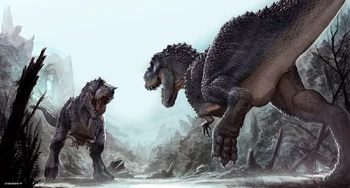
Their forelimbs are small in comparison with the rest of their bodies, not growing as fast as the rest of the animal so that by adulthood this disparity in spite of their size is strikingly evident. Early tyrannosaurids had only two fingers on their forelimbs but Skull Island V. rexes have three. When dragging carcasses, the tiny arms help pin the meat against the body and prevent it swinging around.
While juvenile V. rexes tend to cluster in the thick jungle interior, the large adults hunt mostly in the open areas of the lowlands where they can move freely. Large males seek the most open territories while mature females usually stake claim to areas on the fringes of the thicker forests where they can find hidden nesting sites.
Fiercely territorial, adult V. rexes suffer no rival encroachments on their hunting grounds. Territorial boundaries are regularly marked with feces, and dawn roaring will reinforce claims to land. Neighbors can tell much about the
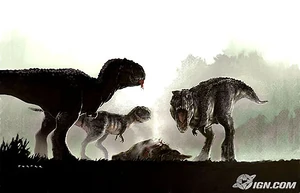
physical condition of the owner of a territory from the smell of its feces and the sound of a roar. Displays and scenting minimize potentially dangerous confrontations between individuals of different sizes. Occasionally disputes between evenly matched V. rexes can erupt. With the threat of serious injury, these confrontations are usually resolved with intense roaring matches in which each individual attempts to intimidate the other into giving way. However, when this fails, violence ensues. Older V. rexes bare the crisscrossing scars of many such fights.
Exceptions to their solitary existence are made in the breeding season. Males will leave their hunting grounds to seek out females in season. If the female is receptive, she will accept the male, and the couple might stay together, hunting in her territory for several days before she tires of him and sends him on his way. Adolescent V. rexes (seeking to hone their hunting skills) will sometimes follow adults at a safe distance during the mating season, watching and occasionally stealing meals from unguarded kills. Taking advantage of the season of nomadic adult males, bold adolescents might move in to claim currently undefended territory as their own.
V. rexes are capable of tackling very large prey species, but their massive size is often employed to intimidate smaller carnivores like Lycaesaurus and Venatosaurus into giving up their kills - they even sometimes eat these smaller predators as well. While effective hunters, a meal is safer to obtain by simply appropriating someone else’s carcass, bullying smaller scavengers like carrion parrots, carrion storks, Foeducrista and giant gray agama. V. rexes have intensely acidic stomachs, capable of processing even the most rancid rotting meat, a feature that serves the species well as heavyweight scavengers. Their massive jaws can exert astounding pressure, shattering bones to expose the rich marrow less robust predators are unable to reach.
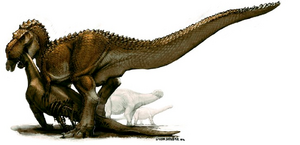
As hunters, V. rexes tend to employ ambush tactics, using cover in and around waterholes or forested areas to surprise prey, like Malamagnus and even Foetodon. Ligocristus are the primary prey of adult V. rexes, being the most abundant. Ferrucutus, Pinnatono, and Brontosaurus are more dangerous prospects; however, if a young or sick individual can be separated from the protection of the herd it can be an easy kill. Any smaller species are likely game, though most are too small to provide more than a snack. The greatest challenger for the hunters lies in not being spotted by prey. Adult V. rexes are dark in coloring and, despite their size, can be surprisingly stealthy, using shadows near the fringes of scrub, rocky outcroppings, or ruins to hide their approach.
Their black scales also aid V. rexes in warming up quickly in the mornings, boosting their energy levels to gain an advantage over still sluggish herbivores (despite many being warm-blooded).
A Story in Skulls[]

The extent to which Skull Island’s V. rexes had developed since the Cretaceous Tyrannosaurus is most in evidence by comparison between skulls. Developments traced through an inferred missing link species show how the skulls became more robust and heavily armored, culminating in that of the Skull Island species.
Skeletal Adaptations[]
V. rexes have large, broad, three-toed feet. These big feet are an adaptation that allows the heavy animals to hunt and stalk through swampier terrain than their bulk will otherwise support. Their huge jaws are among the largest of any land predator to have lived and capable of exerting astonishing pressure to splinter bone and crush limbs. Their teeth are peg-like rather than edged, for piercing and mashing.
Jungle Delinquents[]
Pregnant V. rexes lay their eggs in huge mounds of collected leaf litter in secluded spots in the jungle. The natural decomposition of the detritus provides an ideal incubation for the developing embryos, freeing the mother to wander in search of food. Periodically the mother will return to the nest site to defecate on the mound, the pungent scent being enough to ward off most marauders, though not all. The stealthy Adlapsusaurus seems immune to the dire warning given off by the feces. In fact it is drawn to the scent like a dinner bell and specializes in raiding nests, even those of a V. rex. It will make stealthy sorties to retrieve its prize before retreating to a hidden den to eat.

V. rexes hatch unassisted as tiny near-replicas of their parents and are precocial, being completely capable of taking care of themselves from the moment of emergence. Hunting in the jungle undergrowth, they graduate to taking larger and larger prey as they grow, starting out with certain centipedes and lizards sniffed out in the leaf litter.
Grouping together in small packs of similar aged individuals for protection, young V. rexes will take down larger prey together, but without any of the sophisticated coordination characteristic of Venatosaurus packs. The young tyrannosaurs will remain in these loose affiliations until the onset of puberty, when their size begins to inhibit their effectiveness as jungle predators, forcing them into the more open forests and plains of the lowlands.
Until maturity, V. rexes bare strong barring, which helps camouflage them in the jungle. While still young, they are potential prey for other carnivores, so the striped green and black of their hides helps conceal them from threats as much as it assists their own hunting.
While in their packs, the pugnacious juveniles take advantage of their strength of numbers to bully other carnivores
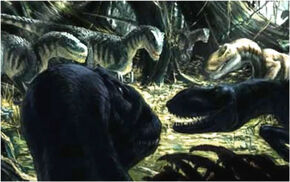
off kills. On a gang of hungry, young V. rex toughs, the subtle posturing and warning hoots of a Venatosaurus pack defending a kill are lost and conflict is inevitable. Unseasoned in the art of sizing up opponents, young V. rexes often bare injuries sustained in contest with the dangerous Venatosaurus, and deaths are not unheard of when clumsy challenges over food go awry.
Scenting Venatosaurus chicks in a nest, a gang of premature V. rexes might also attempt to bully a lone sentinel off guard duty to get to the chicks, only to be surprised by the rest of the pack returning in response to the guard’s alarm calls. The black jungle is an unforgiving school for young carnivores and attention among the students is fierce. Only the quick learners survive to graduate as adults.
Theorized Connection to the Evolution of Carnictis[]
It is theorized that long ago, a V. rex or a similar predator fell into one of the chasms and died, its parasite cargo disgorging slowly from the carcass to find themselves in the rich organic river in the pit’s base. Instead of drying up and dying, they thrived. They became the predatory Carnictis.
Relationship with Kongs[]

There is an age-old enmity that exists between the giant Kongs and the V. rexes. Both immensely powerful animals, these great titans clash again and again in ground-shaking contests of tooth versus fist, tyrannosaur bloodlust versus primate cunning.
V. rexes view young Kongs as food and are brave or foolish enough to risk injury to get at them. Both species take the opportunity to kill the young of the other in an attempt to eliminate future threats and neither accepts the encroachment of the other into their territory. Subadult V. rexes, less wary than their seniors and in a hurry to establish territories of their own, will be led into conflict with the apes.
The apes use whatever lays at hand as weapons, and the V. rexes come armed with massive, crushing gin-trap jaws. The beasts can inflict savage wounds upon one another. Most clashes are short – one party backing off when the odds are evaluated as out of their favor. But when the stakes are high enough, the conflicts become battles to the death
